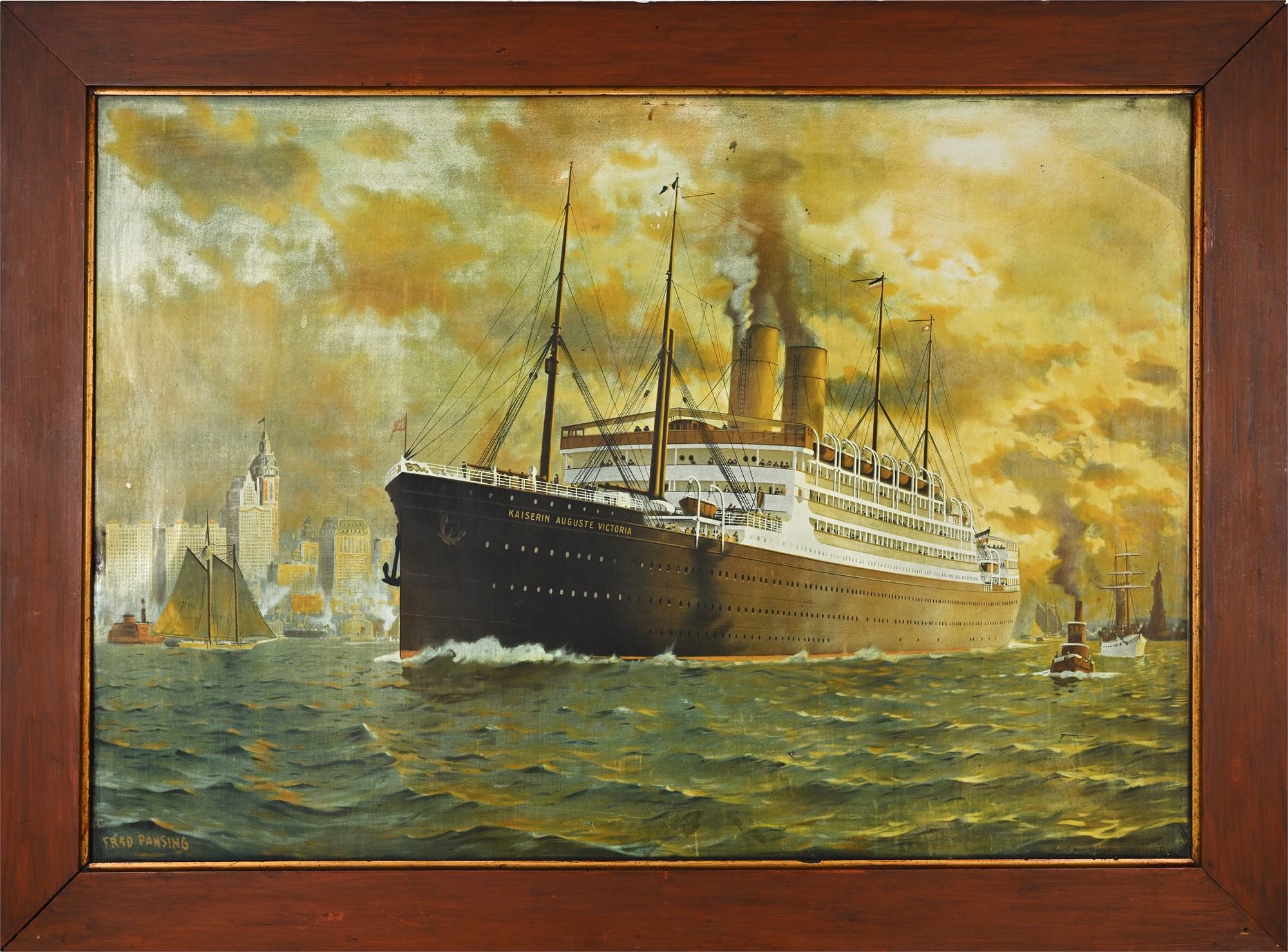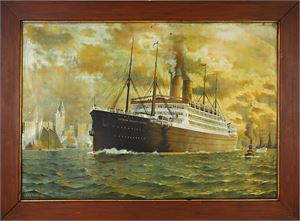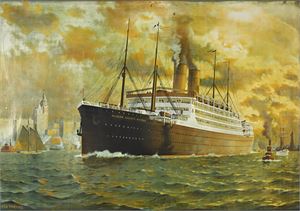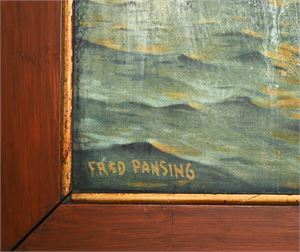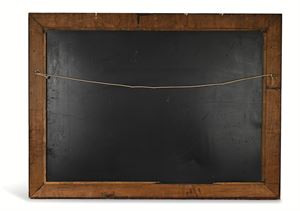Fred Pansing Kaiserin Auguste Victoria Lithographed Tin Sign — c.1910 View Watchlist >
- Winning Bid: $160.00
- 43 Bid(s) View Bid History
- High Bidder: VinnyBoomBats
Seller Accepts Credit Cards
Payment and pickup instructions will be available on your invoice (under "My Account") at the conclusion of this auction.
Lot # H141
System ID # 23593616
Start Date
End Date
4 Watching
Fred Pansing Kaiserin Auguste Victoria Lithographed Tin Sign — c.1910
A rare and visually arresting example of early 20th‑century maritime advertising art, this large lithographed metal sign depicts the Hamburg‑America Line’s celebrated ocean liner Kaiserin Auguste Victoria. Created by acclaimed German‑American marine artist Fred Pansing (1844–1912), whose precision and drama made him a favorite of major shipping lines, the scene shows the great vessel steaming proudly into New York Harbor beneath a dramatic golden sky, flanked by the skyline, tugboats, and sailing ships of a bustling port.
Launched in 1905 in Stettin, Germany, Kaiserin Auguste Victoria was, at the time, the largest and most luxurious liner in the world. She served the Hamburg–New York route until the First World War, later carrying U.S. troops home before entering the Cunard and Canadian Pacific fleets. Renamed Empress of Scotland in 1921, she remained in service until her scrapping in 1934. Pansing’s work captures her at the height of the grand transatlantic era, when ocean liners were both engineering marvels and national symbols of prestige.
Produced by Beach Art Display of Coshocton, Ohio — a major center for lithographic advertising — this sign was likely displayed in a shipping office, travel agency, or steamship ticket bureau. Lithographed on metal, it retains a rich depth of color and a durability that, more than a century later, still evokes the romance and excitement of luxury sea travel.
Housed in its original rustic solid‑wood frame with gilt liner (no glass, as issued), this example remains an imposing artifact of maritime history and a commanding decorative statement piece.
Condition: Good, with scratches, faint abrasions, and small chips to the frame and image surface consistent with age and display. Colors remain vibrant, and wear does not detract from the ship’s strong visual presence.
Dimensions:
Framed: 35.5" × 48"
Image: 28.5" × 40.5"
About the Artist
Fred Pansing (1844–1912) was a German‑born American marine painter and lithographer celebrated for his technical accuracy and dramatic seascapes. Trained as a sailor before turning to art, Pansing possessed firsthand knowledge of ship design, rigging, and the interplay of light and water. His paintings and lithographs were commissioned by major transatlantic shipping companies — including the Hamburg‑America Line, Cunard, and White Star — to promote the grandeur and reliability of ocean travel. Known for blending documentary precision with painterly atmosphere, his works remain among the most sought‑after in marine art.
About the Ship
The Kaiserin Auguste Victoria was launched in 1905 at the Vulcan Shipyard in Stettin, Germany, for the Hamburg‑America Line. Measuring 677 feet in length and boasting twin funnels, four masts, and accommodations for over 2,400 passengers, she was the largest passenger liner in the world at her debut. Her interiors epitomized Edwardian elegance, with sweeping staircases, refined dining salons, and luxurious staterooms. She plied the Hamburg–New York route until the First World War, when she was seized by the Allies and repurposed for troop transport. Later renamed Empress of Scotland under Canadian Pacific ownership, she served until her retirement in 1934.
Provenance
This particular Art has notable provenance: it originally hung in the historic Windsor Hotel in Denver, Colorado - the city’s first true luxury hotel, opened in 1880. A hub for prominent guests and dignitaries in the American West, the Windsor stood until its demolition in 1960. The sign was purchased at auction in 1959, just prior to the hotel's demolition, and has remained privately held since. This connection adds further historical significance to an already rare and visually impactful piece.
